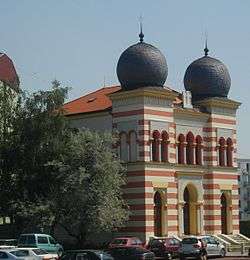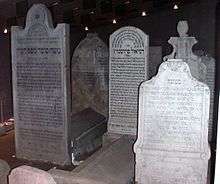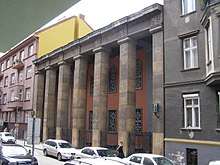History of the Jews in Slovakia
| Total population | |
|---|---|
| 2,600[1] | |
| Languages | |
| Slovak, Hebrew, Yiddish | |
| Religion | |
| Judaism | |
| Related ethnic groups | |
| other Ashkenazi Jews |
| Historical Slovak Jewish population | ||
|---|---|---|
| Year | Pop. | ±% |
| 1921 | 135,918 | — |
| 1930 | 136,737 | +0.6% |
| 1945 | 24,000 | −82.4% |
| 1970 | 7,000 | −70.8% |
| 2000 | 2,700 | −61.4% |
| 2010 | 2,600 | −3.7% |
| Source: [2][3][1] | ||
The History of the Jews in Slovakia goes back to the 11th century, when the first Jews settled in the area.
Early history
In the 14th century, about 800 Jews lived in Bratislava, the majority of them engaged in commerce and money lending. In the early 15th century, a Jewish cemetery was established at Tisinec and was in use until 1892.
In 1494, a blood libel caused a number of Jews to be burned at the stake, and in 1526, after the Battle of Mohács, Jews were expelled from all major towns. In 1529, thirty Jews were burned at the stake in Pezinok.
In the late 17th century and early 18th century, Jews began to return to their original cities and establish organized communities, though they were barred from many trading industries and often in conflict with non-Jews. In 1683, hundreds of Jews from Moravia fled to Slovakia, seeking refuge from Kuruc riots and restrictions on their living imposed in Moravia. In 1700, a leading yeshiva was established in Bratislava and recognized by the government. Under Joseph II, Jews received many additional civil liberties.
19th century

In 1867, Slovakia became part of Austria-Hungary and was classified as "Northern Hungary". Jews were fully emancipated in 1867, but an 1868 law did not recognize nationalities other than Hungarian, which put the Jews in a favorable position compared to their neighbors who refused to renounce their Slovak identity. By the early twentieth century, they controlled 45% of Slovakia's assets despite being only 4% of the population—a situation that exacerbated antisemitism.[4] The Jewish population grew, especially in small, secluded towns in the east. However, widespread antisemitism prevented Jews from assimilating. In 1882 and 1883, antisemitic rioting occurred in several towns.
In 1896, the "Reception Law" was introduced. Under this law, Judaism and Christianity were placed on an equal level. Shortly afterward, the Slovak Clerical People's Party was formed. Its main interests were anti-liberalism and limiting Jewish influence.
During the 19th century and early 20th century, the Zionist movement also reached Slovakia, and eight local Zionist groups were formed. In 1903, Bratislava hosted the First Hungarian Zionist Convention, and the following year, the First World Mizrahi Congress was held there.
20th century
After World War I and the creation of Czechoslovakia in 1918, Jews had the right to declare themselves a separate nationality and prospered in industry and cultural life, holding more than one-third of all industrial investments. In 1919, the National Federation of Slovak Jews and the Jewish Party were established. In the 1929 elections, the Jewish Party won two seats in parliament. In addition, a Jewish newspaper, the "Jewish People's Paper", was first published in Bratislava on August 2, 1919. In the first national census in Czechoslovakia, carried out on February 15, 1921, 135,918 people registered as practicing Jews, and 70,522 declared themselves of Jewish nationality. In addition, there were 165 Orthodox and 52 Reform congregations in the country.
Slovak Jews were divided from their neighbors by language as well as religion; most Slovak Jews spoke Czech, German, or Hungarian for business purposes, while most Gentiles spoke Slovak.[5]
In the 1930s, antisemitic rioting and demonstrations broke out, incited by the Slovak People's Party. During the rioting, professional Jewish boxers and wrestlers took to the streets to defend their neighborhoods from antisemitic gangs, and one of them, Imi Lichtenfeld, would later use his experiences to develop Krav Maga.[6]
The Holocaust

Some 5,000 Jews emigrated before the outbreak of World War II and several thousands afterwards (mostly to the British Mandate of Palestine), but most were killed in the Holocaust. After the Slovak Republic proclaimed its independence in March 1939 under the protection of Nazi Germany, the pro-Nazi regime of President Jozef Tiso, a Catholic priest, began a series of measures aimed against the Jews in the country, first excluding them from the military and government positions. The Hlinka Guard began to attack Jews, and the "Jewish Code" was passed in September 1941. Resembling the Nuremberg Laws, the Code required that Jews wear a yellow armband and were banned from intermarriage and many jobs. By 1940, more than 6,000 Jews had emigrated. By October 1941, 15,000 Jews were expelled from Bratislava; many were sent to labor camps, including Sereď.
Originally, the Slovak government tried to make a deal with Germany in October 1941 to deport its Jews as a substitute for providing Slovak workers to help the war effort. The initial terms were for 20,000 young men aged 16 and older for forced labour, but the Slovak government was concerned that it would leave many aged, sick, or child Jews who would become a burden on the gentile population. A deal was reached where the Slovak Republic would pay 500 Reichmarks for each Jew deported, and in return, the Germans would deport entire families and promise that the Jews would never return. This was billed as a humanitarian measure that would keep Jewish families together;[lower-alpha 1] the Slovak fascist authorities claimed that they did not know that the Germans were systematically exterminating the Jews under its control. Some Jews were exempt from deportation, including those who had converted before 1939.[7]
The deportations of Jews from Slovakia started on March 25, 1942.[lower-alpha 2] Transports were halted on October 20, 1942. A group of Jewish activists known as the Bratislava Working Group tried to stop the process through a mix of bribery and negotiation. However, some 58,000 Jews had already been deported by October 1942, mostly to the Operation Reinhard death camps in the General Government in occupied Poland and to Auschwitz. More than 99% of the Jews deported from Slovakia in 1942 were murdered in the concentration death camps.
Jewish deportations resumed on September 30, 1944, after German troops occupied the Slovak territory in order to defeat the Slovak National Uprising. During the German occupation, up to 13,500 Slovak Jews were deported (mostly to Auschwitz where most of them were gassed upon arrival), principally through the Jewish transit camp in Sereď under the command of Alois Brunner, and about 2,000 were murdered in the Slovak territory by members of the Einsatzgruppe H of the Sicherheitspolizei and the SD and their, mostly Slovak, collaborators. Deportations continued until March 31, 1945 when the last group of Jewish prisoners was taken from Sereď to the Terezín ghetto. In all, German and Slovak authorities deported about 71,500 Jews from Slovakia; about 65,000 of them were murdered or died in concentration camps. The overall figures are inexact, partly because many Jews did not identify themselves, but one 2006 estimate is that approximately 105,000 Slovak Jews, or 77% of their prewar population, died during the war.[9]
After World War II
.jpg)
11 Jews were murdered by an unidentified UPA group in September 1945 in Kolbasov.[10]
In Topoľčany pogrom 48 Jews were seriously injured. 13 anti-Jewish incidents called partisan pogroms took place 1–5 August 1946, the biggest one in Žilina, where 15 people were wounded.[11][12] Anti-Semitic manifestations took place in Bratislava in August 1946 and in August 1948.[13]
In 1946, the Slovak writer Karel František Koch argued that the anti-semitic incidents that he witnessed in Bratislava after the war were "not antisemitism, but something far worse—the robber’s anxiety that he might have to return Jewish property [stolen in the Holocaust],"[14] a view that has been endorsed by Czech-Slovak scholar Robert Pynsent.[15]
After the war, the number of Jews in Slovakia was estimated to 25,000. Most of them decided to emigrate. In February 1948, Communist rule was established after 1948 Czechoslovak coup d'état, lasting until November 1989 Velvet Revolution, and little or no Jewish life existed. Many Jews emigrated to Israel or the United States to regain their freedom of religion. After 1989, and with the peaceful breakup of Czechoslovakia and Slovak independence in 1993, there was some resurgence in Jewish life. However, most Jews were elderly, and younger ones largely assimilated through intermarriage.
Notable Slovak Jews
See also
Notes
References
- 1 2 DellaPergola, Sergio (2016). "World Jewish Population, 2015". In Dashefsky, Arnold; Sheskin, Ira M. American Jewish Year Book 2015. American Jewish Year Book. 115. pp. 273–364. doi:10.1007/978-3-319-24505-8_7. ISBN 978-3-319-24503-4. Reprinted as: DellaPergola, Sergio (2016). "World Jewish Population, 2015". Berman Jewish DataBank.
- ↑ Brod, Petr; Čapková, Kateřina; Frankl, Michal (December 13, 2010). "Czechoslovakia". YIVO Encyclopedia of Jews in Eastern Europe. Retrieved February 9, 2017.
- ↑ Tolts, Mark (October 12, 2010). "Population and Migration: Population since World War I". YIVO Encyclopedia of Jews in Eastern Europe. Retrieved February 9, 2017.
- ↑ Anitra, Van Prooyen, (2012). "Why Did the Trains Stop? The Two Year Cessation of Jewish Deportations from Slovakia". Papers & Publications: Interdisciplinary Journal of Undergraduate Research. 1 (1): 2–3. ISSN 2325-2502.
- ↑
- ↑ Siegel, Nathan (November 6, 2014). "How 1930s Fascism Created Today's Trendiest Self-Defense". OZY.
- ↑ "Slovakia's Righteous among the Nations". www.yadvashem.org. Retrieved 17 July 2018.
- ↑ Gelissen, Rena Kornreich; Macadam, Heather Dune (1996). Rena's Promise: A Story of Sisters in Auschwitz. Boston: Beacon Press. ISBN 978-0-8070-7071-0.
- ↑ Klein-Pejšová, Rebekah (2006). "An overview of the history of Jews in Slovakia". Synagoga Slovaca. Slovak Jewish Heritage Center. Archived from the original on June 17, 2007.
- ↑ "Banderovci očami historikov - pohľad tretí Michal Šmigeľ: Vraždy Židov a komunistov na severovýchodnom Slovensku v roku 1945 - Kolbasovská tragédia" [Bandera eyes of historians - a third-Michal Smigel: killings of Jews and communists in northeastern Slovakia in 1945 - Kolbašovská tragedy] (in Slovak and Rusyn). Holosky. March 15, 2009.
- ↑ Mlynárik, Ján (August 2006). "Dějiny Židů na Slovensku (Část 15)" [History of the Jews in the Slovak Republic (Part 15)]. CS Magazín (in Slovak). Retrieved February 9, 2013.
- ↑ Schvarc, Michal (March 2007). "Masová exekúcia v Sklenom 21. septembra 1944 v širšom dejinnom kontexte" [The mass execution in Sklené September 21, 1944 in a broader historical context] (PDF). Pamät Národia (in Slovak): 4–13. Archived from the original (PDF) on October 6, 2013.
- ↑ Šmigeľ, Michal (June 17, 2013). "Protižidovské nepokoje v Bratislave (august 1946; august 1948) v atmosfére povojnového antisemitizmu na Slovensku" [Anti-Jewish riots in Bratislava (August 1946, August 1948) in the atmosphere of post-war anti-Semitism in Slovakia]. Druhá svetová (in Slovak). Archived from the original on June 23, 2013.
- ↑ Koch 1946, pp. 131-132.
- ↑ Pynsent 2013, p. 330.
Further reading
- Długoborski, Wacław; Tóth, Desider; Świebocki, Teresa; Mensfelt, Jarek, eds. (2002). The Tragedy of the Jews of Slovakia. Oświęcim–Banská Bistrica: Auschwitz-Birkenau State Museum, Museum of the Slovak National Uprising. ISBN 83-88526-15-4.
- Letz, Róbert (2002). "Jewish Code". In Bartl, Július; Čičaj, Viliam; Kohútová, Mária; Letz, Róbert; Segeš, Vladimír; Škvarna, Dušan. Slovak History: Chronology & Lexicon. Translated by Daniel, David P. Slovenské pedagogické nakladateľstvo. pp. 253–4. ISBN 978-80-08-00400-8.
- Heitlinger, Alena (2011). In the Shadows of the Holocaust and Communism: Czech and Slovak Jews Since 1945. New Brunswick: Transaction. ISBN 978-1-4128-0927-6.
- Gross, Jan T. (1989). "Social Consequences of War: Preliminaries to the Study of Imposition of Communist Regimes in East Central Europe". East European Politics & Societies. 3 (2): 198–214. doi:10.1177/0888325489003002002.
- Conway, John S. (January 1974). "The Churches, the Slovak State and the Jews 1939-1945". The Slavonic and East European Review. 52 (126): 85–112. JSTOR 4206836.
- Sniegon, Tomas (2008). Den försvunna historien: Förintelsen i tjeckisk och slovakisk historiekultur [The Lost Story: Holocaust in the Czech and Slovak History, Culture] (Thesis) (in Swedish). Lunds Universitet. ISBN 978-91-628-7530-5.
- Bútorová, Zora; Bútora, Martin (August 1992). "Wariness Towards Jews as an Expression of Post-Communist Panic: The Case of Slovakia". Czechoslovak Sociological Review. 28: 92–106. JSTOR 41133197.
- Jelinek, Yeshayahu (1971). "The 'Final Solution' – The Slovak Version". East European Quarterly. 4 (4): 431.
- Hilberg, Raul (2003). "Slovakia". The Destruction of the European Jews, Volume 2. pp. 766–92. ISBN 978-0-300-09587-6.
- Klein-Pejšová, Rebekah (2015). Mapping Jewish Loyalties in Interwar Slovakia. Bloomington: Indiana University Press. ISBN 978-0-253-01562-4.
- Paulovicova, Nina (2012). Rescue of Jews in the Slovak state (1939-1945) (Thesis). University of Alberta. doi:10.7939/R33H33. OCLC 786281266.
- Jelinek, Yeshayahu (September 1967). "The Role of the Jews in Slovak Resistance". Jahrbücher für Geschichte Osteuropas. 15 (3): 415–22. JSTOR 41043311.
- Jelinek, Yeshayahu A. (1989). "Slovaks and the holocaust: Attempts at reconciliation". Soviet Jewish Affairs. 19 (1): 57–68. doi:10.1080/13501678908577626.
- Kulka, Erich (1989). "The Jews in Czechoslovakia between 1918 and 1968". In Stone, Norman; Strouhal, Eduard. Czechoslovakia: Crossroads and Crises, 1918–88. pp. 271–96. doi:10.1007/978-1-349-10644-8_15. ISBN 978-1-349-10646-2.
- Klein-Pejšová, Rebekah (2009). "'Abandon Your Role as Exponents of the Magyars': Contested Jewish Loyalty in Interwar (Czecho)Slovakia". AJS Review. 33 (2): 341–62. doi:10.1017/S0364009409990043.
- Koch, Karel František (1946). Slovo má lidskost. Prague: Vladimír Žikeš.
- Pynsent, Robert B. (18 July 2013). "Conclusory Essay: Activists, Jews, The Little Czech Man, and Germans" (PDF). Central Europe. 5 (2): 211–333. doi:10.1179/174582107x190906.
